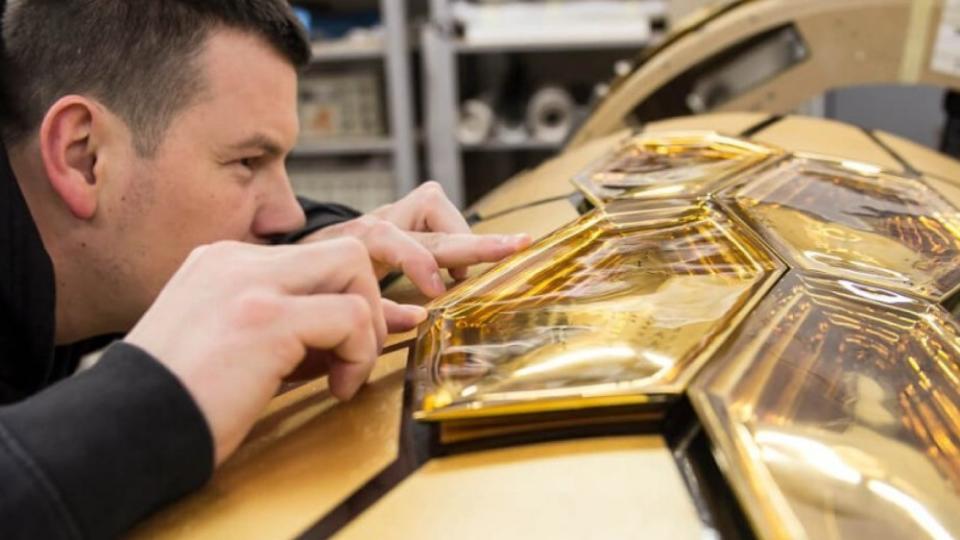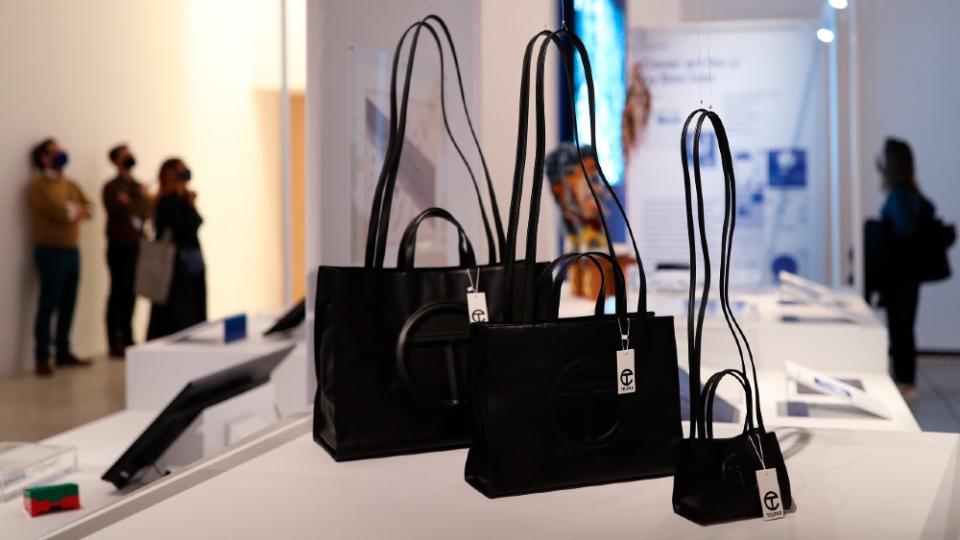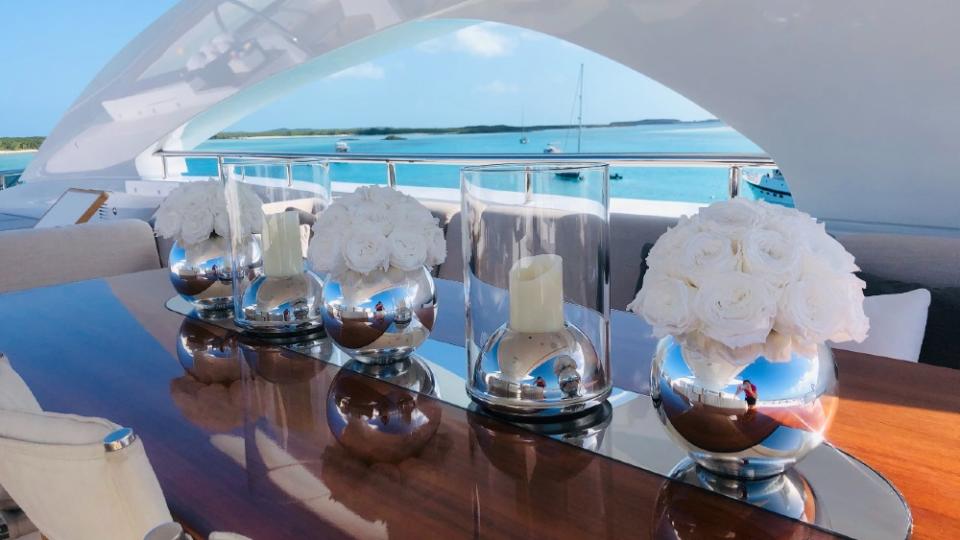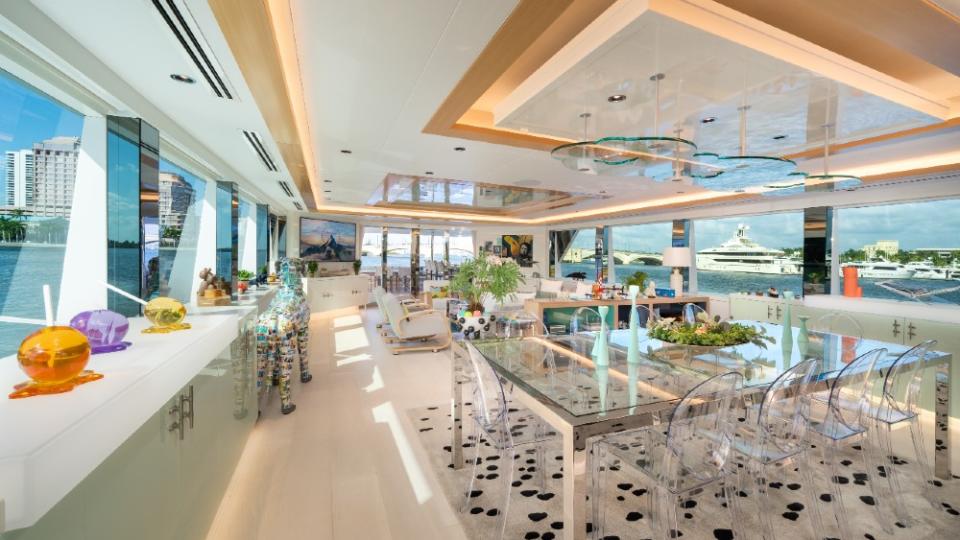Superyacht Interiors Are Going Vegan, but Progress Is Slow. Here’s Why.

“Vegan” is not necessarily a word you’d connect with luxury yacht interiors, but Westport designer Sylvia Bolton is seeing more interest. For Bolton, the meaning of vegan has changed dramatically from her first design 15 years ago when the yacht’s owners, who held their African safaris dear to their hearts, had asked the designer to cover the interior and pilothouse in tribal artifacts and animal pelts, including leopard-skin and zebra-print rugs, to give a realistic African sensibility.
“Everything was artificial,” Bolton told Robb Report, “though the animal skins looked so real they startled the guests.”
More from Robb Report
Boat of the Week: This Whimsical 112-Foot Superyacht Has a Vegan Interior Inspired by Tintin
With 5 Locations, the 2022 Miami International Boat Show Goes Big--and the Crowds Follow
The second more recent yacht, tintin, was an entirely different concept. It has a whimsical interior, complete with a life-sized papier mache Great Dane, with plenty of bright colors and big surprises—including the character Stewie from Family Guy, peeking out of the visor of a full-sized set of knight’s armor on the deck below. The only sign of animal tracks are the big, stylized paw prints Bolton designed into a custom rug under the dining table. There’s no leather, fur or other animal byproducts. “The owners are big animal-rights’ activists,” says Bolton.

Courtesy Crystal Caviar
These two vegan bookends are a rarity in yacht design, of course, and while vegan is generally a moral or political choice, using synthetics or natural materials like vegan leather brings up a larger debate about the lack of sustainable materials in yacht design. The problem, say the designers and shipyards, is that sustainable, engineered materials are generally seen as “cheap” compared to natural leathers, stones and woods.
“At the end of the day, these owners can buy anything and their yachts are statements of the pinnacle of their lives,” says designer Gregory C. Marshall. “I think the key will eventually be to get them to look at materials differently—to get away from the ‘classic equals luxury’ definition. There are some really interesting materials emerging that are sustainable and attractive.”
One includes crystal chandeliers of completely recycled materials. Marek Landa, founder of Crystal Caviar, said the owner of a 340-foot-plus superyacht asked for him to used recycled glass in what turned out to be the show-stopping chandelier in the yacht’s dining room. “In sculptures, the materials often consist of up to 30-percent recycled glass,” says Landa. “In this, we were able recycle leftover crystal rods from previous projects, crush them into crystal nuggets and use them in this unique new chandelier.”

Courtesy AP
Mark Boddington, the founder of Silverlining, specializes in bespoke furniture for residences, yachts and jets. He has found a use for repurposed woods, including 2500-year-old bog oak, that now are considered museum-quality chairs and tables. “We’ve been inspired by perceived waste materials and seeing how we can transform them into what we call neo-luxury finishes,” says Boddington.
“Sustainable, non-toxic materials from surface fabrics, vegan leathers, seaweed, reclaimed and organic-based materials are becoming more common from traditional suppliers,” adds Alex Mcdiarmid of Mcdiarmid Design.
Bioblu CEO Paolo Bonaveri says his company sources “vegan leathers made from natural substances like apples and grape skin, or for more exotic feelings, from pineapple and cactus,” for superyacht interiors. This nature-inspired, “biophilic” design is a trend the materials industry is pushing twofold, both within residential interior design and with products focusing on nature and wellness.

Courtesy Ethereal Blooms
The fast-growing field of vegan leather is seeing its greatest adoption in fashion among high-end designers like Stella McCartney. Shoes, purses, and other vegan leather-based items are also moving from high design to mainstream retail, with chains like H&M selling mushroom-vegan leather shoes. “I’ve seen some excellent leathers from mushrooms,” adds yacht designer Marshall.
Other designers like Bernardo Zuccon from Zuccon International in Rome are experimenting with fabrics that come from recycled plastics. “We’re starting to propose these materials to our customers, even if they aren’t easy to associate with luxury and wealth,” says Zuccon. “Right now, the percentage of customers interested in these materials is low, though we can see a progressive growth.” The good news, he adds, is that these recycled materials are becoming readily available.
“We’re doing research on composite materials from recycled plastics to make the entire structure sustainable and not just the surface,” adds Francesca Burdisso of Burdisso & Capponi Yacht & Design.

Courtesy Caviar Crystal
Other luxury materials, like manufactured marble and teak that employ waste byproducts, are as aesthetically pleasing as the natural forms of the materials, and in some cases, more effective than the originals. Bolton says that engineered flooring and walls developed for high-end hotels and residences are just as attractive and more functional than single pieces of lumber. “These new materials don’t dry and crack like pure wood and they also have anti-flammability properties built into them,” she says. “We just need time to make sure they work well on the constantly changing and often distressed environment that we call a yacht.”
While fresh-flower arrangements are typically used for luxe finishing touches, most have not-so-rosy sustainability credentials. Ethereal Blooms, a London-based floral laboratory, offers 100 percent fresh flowers teamed with the latest biotechnology to create a sustainable on board solution. Its flowers are “bio-preserved” to last up to 12 months in their natural states in the vases.
“Flowers are considered an add-on, but they’re something most yachts replace weekly, much more than other items onboard,” says Joanna Hirst, the company’s yachting specialist. “Using preserved floral arrangements reduces your environmental impact.” At least with the flowers.

Courtesy Fraser Yachts
Floral arrangements may not make a yacht green, but it is the start of a larger movement that will include hull design and propulsion, as well as the adoption of emerging sustainable materials that can replace non-sustainable woods, stones and leather.
“We need to change the idea that luxury means only natural woods, leathers or marble,” says Tankoa Yachts CEO Vincenzo Poerio. “Once the quality is there and scales of efficiency drive the costs down, it will be a matter of marketing.”
Best of Robb Report
The Chevy C8 Corvette: Everything We Know About the Powerful Mid-Engine Beast
The 15 Best Travel Trailers for Every Kind of Road-Trip Adventure
Sign up for Robb Report's Newsletter. For the latest news, follow us on Facebook, Twitter, and Instagram.

